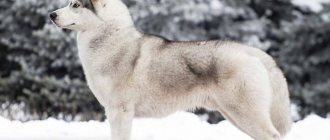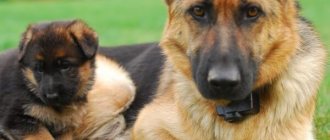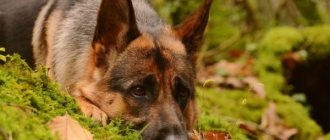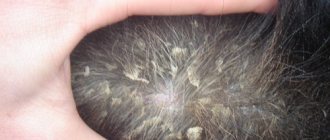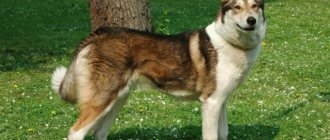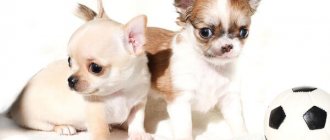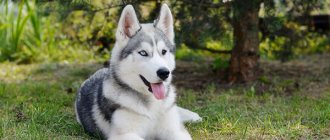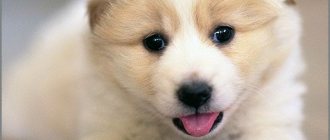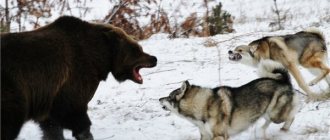Story
Laika is one of the oldest dog breeds. Initially, it was bred by residents of the North, including the Tungus. By crossing with other dogs, representatives of the breed deprived their offspring of the valuable qualities inherent in the husky. To preserve the purity of the breed, northern hunters shot all alien dogs without regret.
Intensive breeding of huskies began in the nineteenth century. Then the husky was called the northern pointy-eared dog. At this time, breed standards were clearly described, and the behavioral characteristics of these dogs during hunting were studied. In 1928, for the first time in Russia, an exhibition was organized where various varieties of huskies were presented.
During the war, huskies were used for transporting goods, as well as for blowing up objects and searching for mines, which reduced the number of representatives of this breed. In order to rectify the situation at the end of the war, dog kennels were created, in particular those that exclusively housed huskies. Intensive breeding of these dogs has provoked the need to establish new breed standards.
Today we have many types of husky breeds. They all differ from other dogs in a common set of character traits.
Laika: hunting characteristics
Laika is one of the best hunting dogs. Representatives of this breed took all the best qualities from their ancestors: excellent scent, vision, dexterity and intuition. The hunting instinct of a husky works even if the dog has never been hunting. They are excellent helpers for commercial hunters. Laikas are good in fishing for:
- fur animals;
- large game: bear, elk and others;
- waterfowl.
A dog of this hunting breed informs its owner about the accomplished fact of catching an animal with a loud bark, but during the hunting process itself the husky behaves very quietly so as not to frighten off the prey.
The husky barks at small game in order to stop it, then crushes it and brings it to the owner, unlike most other dogs, which leave the prey in place. The dog does not gnaw or bite the animal - this is important to preserve the integrity of its skin.
The dog informs its owner about the presence of large game with a piercing bark. Depending on the type of hunting object, the husky can change the frequency of its bark and the tone of its voice. Thanks to this, the hunter recognizes which hunting resource the dog has entered. When chasing game, the husky becomes silent.
Dogs of this breed are universal and can hunt any animal, but if desired, they can be trained to catch only one type of hunting resource. Then, when going hunting, the husky will not disperse its attention to unnecessary objects.
Laikas are not only used for hunting, they are also excellent sled dogs. With great pleasure they will give you a ride in a harness.
These dogs are very loyal to their owner, are not picky and get used to any conditions. That is why they are currently not only used for hunting, but also kept in city apartments.
But huskies, as a rule, are independent and freedom-loving; they are difficult to train. The educational process must begin when the dog is at an early age.
Basic principles for choosing a husky puppy
In ancient times, the selection of puppies from a litter was cruel. The dogs were thrown into ice water and observed for a minute. The most persistent were selected based on the endurance factor, the rest were distinguished by other characteristics of the breed. It was important that the cub did not whine when he was held suspended by the scruff of the neck for a long time. Preference was given to those who fought for the mother's milk, pushing aside the others, and who showed zealous resistance when braking or trying to turn the puppy over. Strict and somewhat cruel tests determined the qualities that would allow the dog to become an excellent hunter of any animal in the future.
A good age for purchasing a baby is 2-3 months. When choosing a new friend, it is better to spend several days observing the litter. This will help draw conclusions about the activity, habits and character of the kids. Preference is given to well-fed and frisky ones. Body proportions play an important role. It is desirable that the puppy's height at the withers corresponds to the length of the body. If the dog is lethargic, has thin paws and often whines, illness or developmental pathologies are possible.
Why doesn't a husky puppy have erect ears?
There are a huge variety of reasons why a husky’s ears won’t stand up, ranging from lifestyle, nutrition and ending with genetics. So, the main reasons why there are problems with floppy ears are:
- Heredity. It’s not for nothing that we keep telling you, carefully study the pedigree and find out everything about the parents from the puppy’s owners. Such curiosity will help to avoid problems with your pet’s health in the future.
- Weak immunity. If an animal’s body is weakened and exhausted, it simply has nowhere to get strength and energy for such an important and complex process.
- Unbalanced diet. Every day, a growing body must consume a sufficient amount of micro and macro elements, vitamins and minerals. Their deficiency may well provoke problems with ear lifting.
- Lifestyle. Yes Yes exactly. A sedentary lifestyle negatively affects the development of cartilage and bones, which can also cause a problem when a husky’s ears don’t stand up.
By the way, excessive force loads and overfatigue also negatively affect the exterior characteristics of the animal, so you should not overdo it. Everything should be in moderation.
- Vaccinations. It happens that only the husky’s ears seem to go up, and then suddenly a vaccination is given, and everything is back to normal. In this case, there is no need to worry. When the body adapts and the condition returns to normal, the process will start again.
- Stressful state. Psychological problems and stress are not alien to animals and sometimes become the causes of serious developmental deviations and even diseases.
We have figured out the reasons, all that remains is to figure out what to do if your pet’s ears still don’t want to take the correct position.
Causes of the problem
When a husky puppy’s ears stand up, the following factors may interfere with the process:
- Heredity (when purchasing a puppy, you need to familiarize yourself with its pedigree, find out whether the dog’s ancestors had ear problems).
- The animal’s well-being (weakened immunity can cause the ears to fall off).
- Diet (the puppy’s diet should contain enough vitamins and microelements for its proper development).
- The degree of activity of the pet (insufficient activity negatively affects the development of bones and cartilage, excessive activity causes overwork, which also has a bad effect on appearance).
- Vaccinations can also negatively affect the condition of a dog's ears.
- Stress.
During the period when the husky's ears stand up, the replacement of milk teeth with molars may begin. At this time, even erect ears can fall and remain in a hanging position for up to six months.
So, what time a husky’s ears stand up depends on various reasons. By eliminating the obstacles that have arisen, you can speed up this process.
How to help your pet?
First, we advise you to consult a veterinarian and review your diet. Include as many nutrients as possible and don’t forget about vitamins and daily walks in the fresh air. If the reason was a deficiency of nutrients, the process of formation will begin.
You can also massage your ears yourself. Using circular movements, massage your ear from the base to the top, as if stretching. As practice shows, this measure has a good effect on lifting and brings a lot of pleasure to the pet.
If the above measures do not help to cope with the problem, it is worth moving on to heavy artillery. For this:
- shave the fur and thoroughly clean the ears;
- roll up cotton pads and wrap them into tubes with gauze;
- apply a gauze tube and wrap the ear cartilage with the same tube;
- fix the structure with a hypoallergenic plaster;
- connect the two ears to each other at the top of the head in the position in which they should be in the future.
Your pet should walk with this design for at least two weeks. If, after removing it, your husky's ears fall off, repeat the procedure again until a stable result is obtained.
Important! Once every two to three days, be sure to unwrap the tubes and check if the ears are starting to become inflamed. This is especially true in the summer, when the heat outside and in the house is unbearable. If they start to hum, be sure to remove the constructed structure, clean and treat the ear, sprinkle with baby powder or talcum powder. Now you can wrap again, but always keep the issue under control. Problems and inflammation of the ears are of no use to us.
If you find an error, please select a piece of text and press Ctrl + Enter.> Husky puppy ears
At what age do a husky puppy's ears begin to stand up?
Why don't my ears go up?
The time it takes for husky shells to rise is due to the following reasons:
- Hereditary factor. When purchasing a Laika puppy, it’s a good idea to inquire about the dog’s parents and the timing of the development of the father’s and mother’s exterior. It’s even better to find out how things were with the dog’s grandparents. Check with the breeder about the presence of such difficulties in advance, but do not expect that the seller will certainly admit it.
- The state of health and well-being of the four-legged animal. This reason influences the position of the ear, perhaps to a greater extent than genetic predisposition. Adult females sometimes lose their shells after a false pregnancy.
- Poor nutrition of the dog, lack of proteins, vitamins, and microelements in the diet.
- A sedentary lifestyle and lack of physical activity affect the cartilage and bones of the body, including the ears. The opposite picture is also possible: excessive activity, which overtires the animal, has a negative effect on its appearance. The reasons may be long trips, participation in exhibitions.
- Diseases, previous injuries and vaccinations can do their dirty work.
Pets' ears may collapse during the period of teeth change. Large puppies with thick, fleshy ears can droop for almost six months.
When a husky's ears stand up
At what age should ears go up?
All newborn puppies, regardless of breed, are characterized by small ears that are pressed tightly to the skull. During this period, they are shapeless, so it is impossible to accurately determine their position (hanging or standing).
With age, the cartilage tissue becomes denser, and as a result, the ears begin to rise. During this period, the differences between straight-eared and lop-eared dogs become most obvious.
Puppies usually develop ears between 2 and 5 months of age. But still, the exact age depends on the specific breed of dog:
- In Yorkshire Terriers, ear lifting is observed as early as 2 months;
- For a shepherd puppy - at 4-5 months;
- For larger breeds – 5-6 months.
If the ears do not rise within the specified period, then the pet may have some abnormalities or abnormalities. In this case, they will not rise on their own, so the owner can take some measures to ensure that they become erect, rather than lying down. If in a large dog at 3 months they lie in soft rags and do not plan to rise, then active actions can be started already this month.
But it is still worth noting that in some breeds the ears can take a straight position only at 6-8 months. In order not to harm your pet, it is better to first consult with a specialist; he will be able to find the reason for the late raising of shells and identify possible problems.
Important! Sometimes the process of raising a dog's ears can be very slow. The owner must carefully monitor their condition. It happens that everything is restored within a few weeks, but sometimes the ears may fall and not rise again.
When to be wary
If by 7-8 months at least one ear is not standing or both ears are lying like rags, then it will be very difficult to achieve the desired results. Concha placement in adult animals is often performed with the help of a surgeon. But still, in order to prevent dangerous consequences, it is worth considering several situations in which the owner’s help may be required:
- Curvature of the bend line. When raised correctly, the ear begins to bend smoothly and forms an arch. If your tailed pet has an angular line, this will greatly increase the risk of a crease;
- Presence of a fold. If there is little time left before lifting, and a small fold appears on the ear, then you should be wary. A crease or scar often appears in this area;
- Lack of progressive development. If your dog has floppy ears that lie like rags, and they are not going to rise in the near future, then it is better to contact a veterinarian. The specialist will identify the cause and perhaps suggest how to help the pet;
- Long retention of ears in the “house” position. Increased load on the base of the auricle leads to the appearance of a crease. An animal can remain with this ear shape for the rest of its life.
